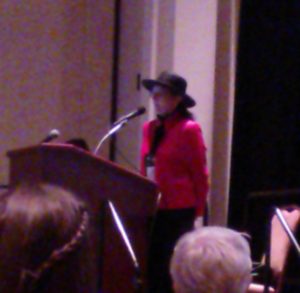SpringBoard, an official blogger for the 2015 National Genealogical Society (NGS) Family History Conference, is pleased to offer a review of this Skillbuilding lecture, presented Wednesday, 13 May 2015.
W121: Barbara Vines Little, CG, FNGS, FVGS, "But I've Looked Everywhere!"
Reviewed by Darcie Hind Posz, CG

Barbara Vines Little, CG, FNGS, FVGS
We create a lot of our own brick walls by making assumptions. We consult the usual sources, such as censuses, vital records, and wills. Each supplies information that may apply to what we are researching. Censuses document family members, ages, relationships, and places of residence and birth. Vital records furnish ages for civil and military service. Wills can sprout numerous other records that grow into new information. Barbara Vines Little's lecture makes researchers think beyond what is originally known, to branch out from that point. The records and resources described give listeners a list of items to obtain, consult, and apply to their own research questions. Little provides examples for each type of record discussed.
What if we have looked everywhere and evidence either does not exist or does not answer what we want to know? We can find alternate sources by following an event, document, or person. An event may not be reported in a particular record, but Little offers several workarounds. For example, a deed may identify a tract or owner. Tracking people on adjacent lands may turn up additional records for all.
Consider the unusual, and read other people's research. Check what they looked at, what they found, and whether you could apply the approach to your research. Collect state, regional, and local histories while looking for unique records, and check out the sources used by the authors of those histories.
Remember that documents can show up in random places, either far from where they were created or nearby but hidden. When located, these documents can be abstracted or transcribed for others to use.
Re-evaluate your conclusions. Why did you decide they were so?
Little recommends broad research. This approach’s effectiveness is demonstrated in lectures and complex case studies, such as those in the NGS Quarterly. There is no silver bullet when it comes to solving genealogical puzzles, but this lecture provides tangible examples that make us ponder the common problems and brick walls we face with our own ancestors.

CG, Certified Genealogist, CGL, and Certified Genealogical Lecturer are service marks of the Board for Certification of Genealogists, used under license by Board-certified genealogists after periodic competency evaluation, and the board name is registered in the US Patent & Trademark Office.